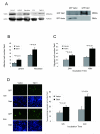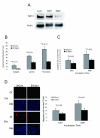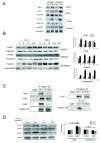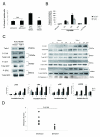Talin1 promotes tumor invasion and metastasis via focal adhesion signaling and anoikis resistance
- PMID: 20160039
- PMCID: PMC2836205
- DOI: 10.1158/0008-5472.CAN-09-2833
Talin1 promotes tumor invasion and metastasis via focal adhesion signaling and anoikis resistance
Abstract
Talin1 is a focal adhesion complex protein that regulates integrin interactions with ECM. This study investigated the significance of talin1 in prostate cancer progression to metastasis in vitro and in vivo. Talin1 overexpression enhanced prostate cancer cell adhesion, migration, and invasion by activating survival signals and conferring resistance to anoikis. ShRNA-mediated talin1 loss led to a significant suppression of prostate cancer cell migration and transendothelial invasion in vitro and a significant inhibition of prostate cancer metastasis in vivo. Talin1-regulated cell survival signals via phosphorylation of focal adhesion complex proteins, such as focal adhesion kinase and Src, and downstream activation of AKT. Targeting AKT activation led to a significant reduction of talin1-mediated prostate cancer cell invasion. Furthermore, talin1 immunoreactivity directly correlated with prostate tumor progression to metastasis in the transgenic adenocarcinoma mouse prostate mouse model. Talin1 profiling in human prostate specimens revealed a significantly higher expression of cytoplasmic talin1 in metastatic tissue compared with primary prostate tumors (P < 0.0001). These findings suggest (a) a therapeutic significance of disrupting talin1 signaling/focal adhesion interactions in targeting metastatic prostate cancer and (b) a potential value for talin1 as a marker of tumor progression to metastasis.
Figures





Similar articles
-
Talin1 phosphorylation activates β1 integrins: a novel mechanism to promote prostate cancer bone metastasis.Oncogene. 2015 Apr 2;34(14):1811-21. doi: 10.1038/onc.2014.116. Epub 2014 May 5. Oncogene. 2015. PMID: 24793790 Free PMC article.
-
Differential effect of the focal adhesion kinase Y397F mutant on v-Src-stimulated cell invasion and tumor growth.J Biomed Sci. 2005;12(4):571-85. doi: 10.1007/s11373-005-7212-5. Epub 2005 Nov 10. J Biomed Sci. 2005. PMID: 16132110
-
Novel pharmacologic targeting of tight junctions and focal adhesions in prostate cancer cells.PLoS One. 2014 Jan 31;9(1):e86238. doi: 10.1371/journal.pone.0086238. eCollection 2014. PLoS One. 2014. PMID: 24497940 Free PMC article.
-
Significance of talin in cancer progression and metastasis.Int Rev Cell Mol Biol. 2011;289:117-47. doi: 10.1016/B978-0-12-386039-2.00004-3. Int Rev Cell Mol Biol. 2011. PMID: 21749900 Free PMC article. Review.
-
Targeting anoikis resistance in prostate cancer metastasis.Mol Aspects Med. 2010 Apr;31(2):205-14. doi: 10.1016/j.mam.2010.02.001. Epub 2010 Feb 11. Mol Aspects Med. 2010. PMID: 20153362 Free PMC article. Review.
Cited by
-
The Potential of Extracellular Matrix- and Integrin Adhesion Complex-Related Molecules for Prostate Cancer Biomarker Discovery.Biomedicines. 2023 Dec 28;12(1):79. doi: 10.3390/biomedicines12010079. Biomedicines. 2023. PMID: 38255186 Free PMC article. Review.
-
Expression of Talin-1 in endometriosis and its possible role in pathogenesis.Reprod Biol Endocrinol. 2021 Mar 9;19(1):42. doi: 10.1186/s12958-021-00725-0. Reprod Biol Endocrinol. 2021. PMID: 33750407 Free PMC article.
-
Nuclear localization of parathyroid hormone-related peptide confers resistance to anoikis in prostate cancer cells.Endocr Relat Cancer. 2012 May 3;19(3):243-54. doi: 10.1530/ERC-11-0278. Print 2012 Jun. Endocr Relat Cancer. 2012. PMID: 22291434 Free PMC article.
-
Promotive effect of Talin-1 protein on gastric cancer progression through PTK2-PXN-VCL-E-Cadherin-CAPN2-MAPK1 signaling axis.J Clin Lab Anal. 2020 Dec;34(12):e23555. doi: 10.1002/jcla.23555. Epub 2020 Sep 20. J Clin Lab Anal. 2020. PMID: 32951272 Free PMC article.
-
Carcinoma matrix controls resistance to cisplatin through talin regulation of NF-kB.PLoS One. 2011;6(6):e21496. doi: 10.1371/journal.pone.0021496. Epub 2011 Jun 24. PLoS One. 2011. PMID: 21720550 Free PMC article.
References
-
- Fornaro M, Manes T, Languino LR. Integrins and prostate cancer metastases. Cancer Metastasis Rev. 2001;20(34):321–31. - PubMed
-
- Frisch SM, Screaton RA. Anoikis mechanisms. Current opinion in cell biology. 2001;13(5):555–62. - PubMed
-
- Giancotti FG, Ruoslahti E. Integrin signaling. Science. 1999;285(5430):1028–32. - PubMed
Publication types
MeSH terms
Substances
Grants and funding
LinkOut - more resources
Full Text Sources
Medical
Molecular Biology Databases
Miscellaneous

